Linear Programming Exercise 12.1
Solve the following Linear Programming problems graphically.
Question 1. Maximize Z = 3x+4y,
Subject to the constraints x+y≤4, x≥0 and y≥0.
Solution:
We have to
Maximize Z = 3x + 4y
Subject to constraints x + y≤4, x≥0, y≥0
Firstly, draw the graph of the line x+y = 4
Then, putting (0, 0) in the inequality x+y≤4 we have 0 + 0≤4
⇒ ≤4 (Which is true)
So, the half-plane is towards the origin.
Since, x,y≥0
So, the feasible region lies in the first quadrant.
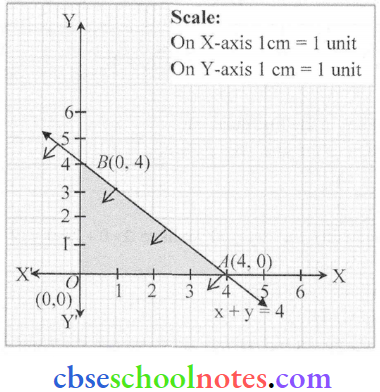
∴ The feasible region is OABO.
The comer points of the feasible region are 0(0,0), A(4,0), and B(0,4), The values of Z at these points are as follows:

Therefore, the maximum value of Z is 16 at the point B(0,4).
Question 2. Minimize Z = -3x + Ay, subject to constraints x + 2y≤8,3x + 2y≤1 2,x≥0 and y≥0.
Solution:
We have to
Minimize Z = -3x+4y
Subject to constraints x+2y≤8, 3x + 2y≤12, x≥0, y≥0
Firstly, draw the graph of the line, x + 2y = 8
Putting (0, 0) in the inequality x + 2y≤8, we have 0 + 0≤8
⇒ 0≤8 (Which is true)
Read and Learn More Class 12 Maths Chapter Wise with Solutions
So, the half-plane is towards the origin.
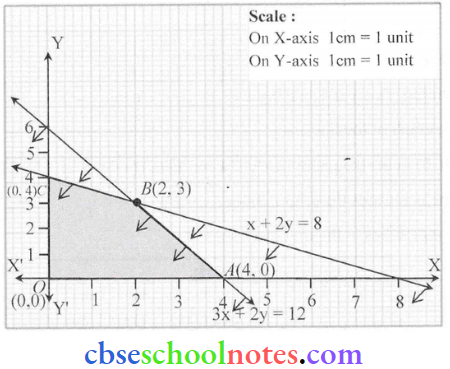
Since, x,y≥0
So, the feasible region lies in the first quadrant.
Secondly, draw the graph of the line, 3x + 2y = 12

Putting (0, 0) in the inequality 3x + 2y≤12 we have 3 x 0 + 2 x 0 ≤ 12
⇒ 0 ≤12 (Which is true)
So, the half-plane is towards the origin.
∴ Feasible region is OABCO.
On solving equations x + 2y = 8 and 3x+2y = 12, we get x = 2 and y = 3
∴ Intersection point B is (2,3)
The corner points of the feasible region are 0(0,0), A(4,0), B(2,3)and C(0,4).
The values of Z at these points are as follows.
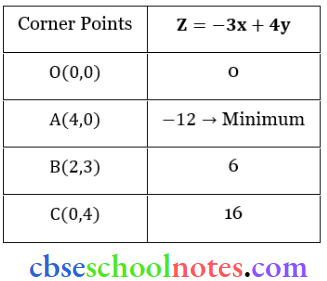
Therefore, the minimum value of Z is -12 at the point A(4,0).
Question 3. Maximize Z = 5x + 3y, subject to constraints 3x + 5y≤ 15. 5x + 2y≤10. x≥0 and y≥0.
Solution:
We have to
Maximize Z = 5x + 3y
Subject to constraints 3x + 5y≤15, 5x + 2y≤10, x≥0, y≥0
Firstly, draw the graph of the line. 3x + 5y = 15
Putting (0, 0) in the inequality 3x + 5y≤15. we have 3 x 0 + 5 x 0≤15
⇒ 0≤15 (Which is true)
So, the half-plane is towards the origin.
Since, x,y ≥ 0 So, the feasible region lies in the first quadrant.
Secondly, draw the graph of the line, 5x + 2y≤10
Putting (0, 0) in the inequality 5x + 2y≤10 we have 5 x 0 + 2 x 0 ≤ 10
⇒ 0≤10 (Which is true)
So, the half-plane is towards the origin.
On solving equations, 3x + 5y = 15 and 5x + 2y = 10, we get x = 20/19 and y = 45/19
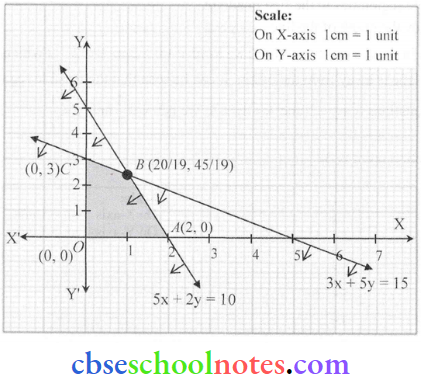
Coordinates of point B is \(\left(\frac{20}{19}, \frac{45}{19}\right)\)
∴ The feasible region is OABCO
The corner points of the feasible region are 0(0,0), A(2,0), B\(\left(\frac{20}{19}, \frac{45}{19}\right)\) and C(0,3)
The values of Z at these points are as follows:

Therefore, the maximum value of Z is \(\frac{235}{19}\) at the point B\(\left(\frac{20}{19}, \frac{45}{19}\right)\)
Question 4. Minimize Z = 3x + 5y subject to constraints x + 3y≥3, x+y≥2 and x,y≥0.
Solution:
We have to
Minimize Z = 3x + 5y
Subject to constraints x + 3y≥3, x+y≥2, x≥0, y≥0
Firstly, draw the graph of the line, x + 3y = 3
Putting (0, 0) in the inequality x + 3y≥3, we have 0 + 3 x 0 ≥ 3
⇒ 0≥3 (Which is false)
So, the half-plane is away from the origin. Since, x,y≥0 So, the feasible region lies in the first quadrant.
Secondly, draw the graph of the line, x+y = 2
Putting (0, 0) in the inequality x + y≥2 we have 0 + 0≥2
⇒ G≥2 (Which is false)
So, the half-plane is away from the origin. It can be seen that the feasible region is unbounded.
On solving equations x+y = 2 and x + 3y = 3, we get x = 3/2 and y = 1/2
∴ Intersection point is B\(\left(\frac{3}{2}, \frac{1}{2}\right)\)
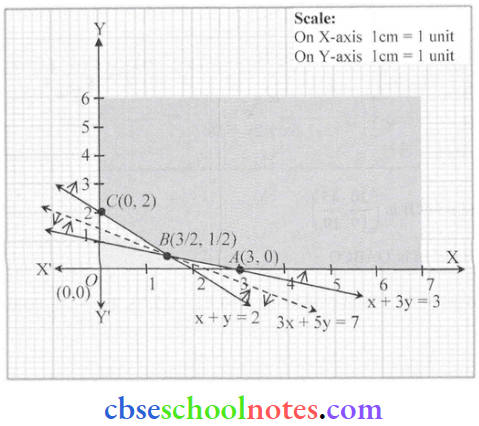
The corner points of the feasible region axe A(3,0), B\(\left(\frac{3}{2}, \frac{1}{2}\right)\) and C(0,2).
The values of Z at these points are as follows:

As the feasible region is unbounded, therefore, 7 may or may not be the minimum value of Z.
For this, we draw the graph of the inequality, 3x + 5y < 7, and check whether the resulting half-plane has points in common with the feasible region or not.
It can be seen that the feasible region has no common point with 3x + 5y < 7.
Therefore, the maximum value of Z is 7 at point B\(\left(\frac{3}{2}, \frac{1}{2}\right)\)

Question 5. Maximize Z = 3x + 2y, subject to constraints x + 2y≤10, 3x + y≤15and x,y≥0.
Solution:
We have to
Maximize Z = 3x + 2y
Subject to constraints x + 2y≤10, 3x + y≤15, x≥0, y≥0
Firstly, draw the graph of the line, x + 2y = 10
Putting (0, 0) in the inequality x + 2y≤10, we have 0 + 2 x 0≤10
⇒ 0 ≤10 (Which is true)
So, the half-plane is towards the origin.
Since, x,y≥0
So, the feasible region lies in the first quadrant.
Secondly, draw the graph of the line, 3x+y = 15
Putting (0, 0) in the inequality 3x+y≤15 we have 3 x 0 + 0 ≤ 15
⇒ 0 ≤ 15 (Which is true)
So, the half-plane is towards the origin.
On solving equations x + 2y = 10 and 3x + y = 15, we get x = 4 and y = 3
∴ Intersection point B is (4,3)
∴ The feasible region is OABCO.

The corner points of the feasible region are 0(0,0), A(5,0), B(4,3)and C(0,5). The values of Z at these points are as follows:
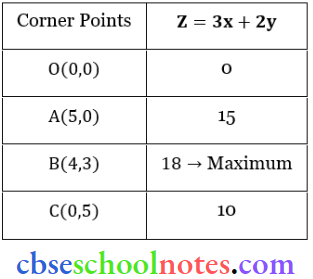
Therefore, the maximum value of Z is 18 at the point B(4,3).
Question 6. Minimize Z = x + 2y, subject to constraints are 2x+y≥3, x + 2y≥6 and x,y≥0. Show that the minimum of Z occurs at more than two points.
Solution:
We have to
Minimize Z = x + 2y
Subject to constraints 2x+y≥3, x + 2y≥6 , x≥0, y≥ 0
Firstly, draw the graph of the line, 2x+y = 3
Putting (0, 0) in the inequality 2x+y≥3, we have 2 x 0 + 0≥3
⇒ 0≥3 (Which is false)
So, the half-plane is away from the origin.
Since, x, y≥0 So, the feasible region lies in the first quadrant.
Secondly, draw the graph of the line, x + 2y = 6
Putting (0, 0) in the inequality x+2y≥6 we have 0 + 2 x 0 ≥ 6
⇒ 0≥6 (Which is false) So. the half plane is away from the origin.
The intersection point of the lines x + 2y = 6 and 2x + y = 3 is B (0,3)
The corner points of the feasible region are A(6,0), and B(0,3). The values of Z at these points are as follows:

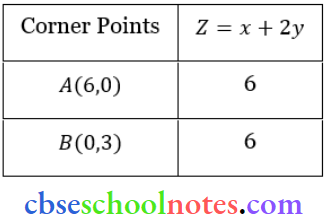
As the feasible region is unbounded, therefore, Z = 6 may or may not be the minimum value. For this, we draw the inequality, x+2y<6, and check whether the resulting half-plane has points in common with the feasible region or not.
Here there is no common point between the unbounded feasible region and the open half plane Therefore, the value of Z is minimum at every point on the line, x+2y = 6.
Question 7. Minimize and maximize Z = 5x + 10y subject to constraints are x+2y≤120, x+y≥60, x-2y≥0and x,y≥0.
Solution:
We have to
Minimize and maximize Z = 5x +10y
Subject to constraints x+2y≤120, x+y≥60, x,y≥0, x-2y≥0
Firstly, draw the graph of the line, x+2y = 120
Putting (0, 0) in the inequality x + 2y≤120, we have 0 + 2 x 0≤120 ⇒ 0≤120 (Which is true) So, the half-plane is towards the origin.
Secondly, draw the graph of the line, x+y = 60
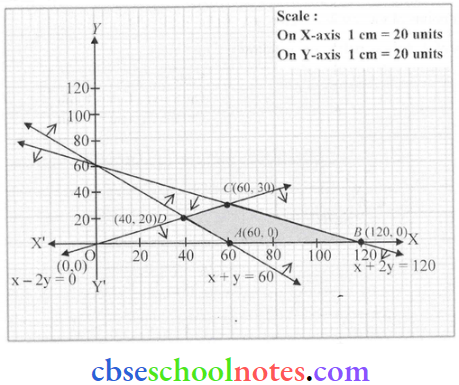
Putting (0, 0) in the inequality x+y≥60, we have 0 + 0≥60
⇒ 0≥60 (Which is false)
So, the half-plane is away from the origin.
Thirdly, draw the graph of the line x- 2y = 0
Putting (5, 0) in the inequality x-2y≥0 we have 5 – 2 x 0 ≥ 0
⇒ 5≥0 (Which is true)
So, the half-plane is towards the A-axis. Since, x,y≥0
So, the feasible region lies in the first quadrant.
∴ The feasible region is ABCDA.
On solving equations x – 2y = 0 and x + y = 60, we get D(40,20)
And on solving equations x-2v = 0 and x+2y = 120 , we get C(60,30)
The corner points of the feasible region are, A(60,0), B(120,0), C(60,30), and D(40,20).
The values of Z at these points are as follows:

The minimum value of Z is 300 at A (60,0) and the maximum value of Z is 600 at all the points on the line segment joining the points B (120, 0) and C (60, 30).
Question 8. Minimize and maximize Z = x + 2y subject to constraints are x + 2y≥100, 2x -y≤ 0,
2x + y≤200 and x,y≥0.
Solution:
We have to
Minimize and maximize Z = x+2y
Subject to constraints x+2y≥100, 2x-y≤ 0, 2x + y≤200, x≥0, y≥ 0
Firstly, draw the graph of the line, x + 2y = 100
Putting (0, 0) in the inequality x + 2y≥100, we have 0 + 2×0≥100
⇒ 0≥100 (Which is false)
So, the half-plane is away from the origin.
Secondly, draw the graph of the line, 2x -y = 0
Putting (5, 0) in the inequality 2x -y≤0
we have 2 x 5 – 0 ≤ 0
⇒ 10≤0 (Which is false)
So, the half-plane is towards the Y-axis.
Thirdly, draw the graph of the line 2x+y = 200
Putting (0, 0) in the inequality 2x+y≤200 we have 2 x 0 + 0 ≤ 200 ⇒ 0 < 200 (Which is true)
So, the half-plane is towards the origin. Since, x,y ≥ 0 So, the feasible region lies in the first quadrant.

On solving equations 2x-y = 0 and x + 2y = 100 , we get B(20,40)
And on solving equations2x-y = 0and 2x+y = 200 , we get C(50, l00)
∴ The feasible region is ABCDA.
The corner points of the feasible region are, A (0,50), B(20,40), C(50,100), and (0,200).
The values of Z at these points are as follows:
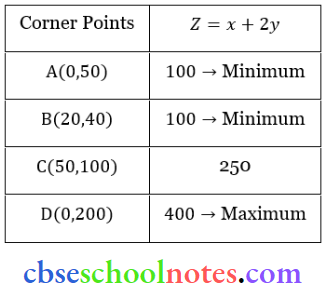
The maximum value of Z is 400 at D(0,200)and the minimum value of Z is 100 at all the points on the line segment joining A(0,50)and B(20,40).
Question 9. Maximize Z = -x + 2y, subject to the constraints x≥3, x + y≥5,x + 2y≥6 and y≥0.
Solution:
We have to
Maximize Z = -x+2y
Subject to constraints x≥3, x + y≥5, x+2y≥6, x≥0, y≥0
Firstly, draw the graph of the line, x+y = 5
Putting (0, 0) in the inequality x+y≥5, we have 0 + 0≥5
⇒ 0≥5 (Which is false)
So, the half-plane is away from the origin.
Secondly, draw the graph of the line, x+2y = 6
Putting (0, 0) in the inequality x + 2y≥6, we have 0 + 2 x 0≥6
⇒ 0≥6 (Which is false)
So, the half-plane is away from the origin.
It can be seen that the feasible region is unbounded.
The corner points of the feasible region are A(6,0), B(4,1) and C(3,2).
The values of Z at these points are as follows;

As the feasible region is unbounded, therefore, Z = 1 may or may not be the maximum value.
For this, we draw the inequality, -x + 2y > 1, and check whether the resulting half-plane has points in common with the feasible region or not.
The resulting feasible region has points in common with the feasible region.
Therefore, Z = 1, is not the maximum value.
Hence, Z has no maximum value.
Question 10. Maximize Z = x+y, subject to constraints are x-y≤-1, -x + y≤0 and x, y≥0.
Solution:
We have to
Maximize Z = x+y
Subject to constraints x-y≤-1, -x + y≤0, x ≥0, y ≥ 0
Firstly, draw the graph of the line, x-y = -1
Putting (0, 0) in the inequality x-y ≤ -1, we have 0-0≤-1
⇒ 0≤-1 (Which is false)
So, the half-plane is away from the origin.
Secondly, draw the graph of the line, -x + y = 0
Putting (2, 0) in the inequality-x+y ≤ 0 we have -2 + 0≤0
⇒ -2≤0 (Which is true)
So, the half-plane is towards the X-axis.
Since, x,y≥0
So, the feasible region lies in the first quadrant.
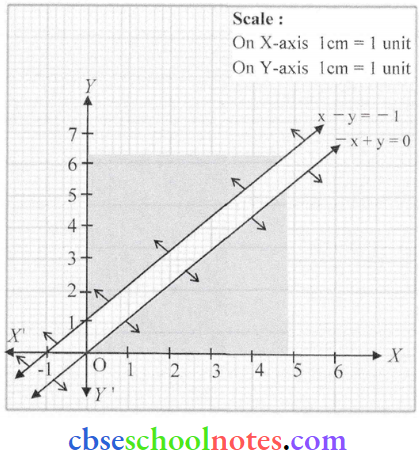
From the above graph, it is clearly shown that there is no common region. Hence, there is no feasible region and thus Z has no maximum value.
